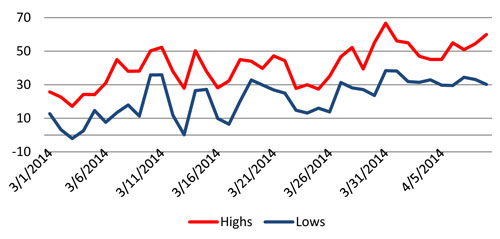Southwest Michigan field crop regional report – April 10, 2014
While spring has been late in arriving, growers in Southwest Michigan are thankful for the return of a week of daytime high temperatures above the freezing mark.
Weather
Snow melt occurred slow enough to allow for even infiltration across the fields. Soil moisture levels continue to remain high, preventing large scale field preparation operations from being conducted. The majority of field operations going on are harvest operations for corn that was unable to be taken off last fall due to a rapid closing in of winter weather conditions and fencerow cleanup of downed trees.
Cassopolis Michigan State University Enviro-weather station daily temperatures

Growing degree day accumulations
As you can see from the chart above, daytime highs have been improving in Southwest Michigan over the last 10 days. However, each night we have tended to drift back near or below the freezing mark. Growing degree day (GDD) accumulations for the Cassopolis MSU Enviro-weather station is 36 GDDs base 50. This compares with 43 GGDs base 50 in 2013 and 65 GDDs bade 50 in 2011. In the record-setting season of 2012, we already had accumulated 320 GDDs by this date (April 10, 2014).
The low heat accumulation paired with snow cover until late March pretty much explains the late breaking of dormancy of wheat and alfalfa crops. With colder temperatures and mixed precipitation in the forecast for next week, we may be in for more of the same for at least the near future. The NOAA 6-10 and 8-14 day outlooks have us remaining in the much colder than normal range, but they do show a drying trend that may help fields begin to be worked.
Crop reports
Wheat is finally beginning to color up in Southwest Michigan. Some of the wheat was planted later than normal here due to challenges in getting the soybean crop off because of green stems and rainfall. Stands look OK, but the plants are quite small at this time. There is not a lot of damage from drowned out areas in fields I have looked at. Warmer conditions are needed to get the crop up and running as soon as possible.
Alfalfa crowns are beginning to set new growth. I have not seen much damage from winter conditions in the sandy fields I have in our immediate area. I have not walked many fields, especially where soils were heavier, so that may not be the case in all areas. The same prescription is needed as for wheat.
As far as field conditions, the ground remains mainly too wet to work throughout the region. Winter annual weed growth remains low following an early winter season and the cold temperatures this spring.
Things to look out for this season
Palmer amaranth has begun a slow spread in some areas of St. Joseph County. Surprisingly few fields have had significant outbreaks of this weed, but as the number of fields that harbor infestations increase, the danger of spreading the weed around to other areas of the region increases rapidly. If you are bringing equipment in and out of St. Joseph and southern Kalamazoo counties, remove the soil and any potential plant residue. It is particularly important to clean out combines.
Be on the lookout for any pigweed escapes and be prepared to apply post emergent herbicide treatments while these escapes are small. If you find patches of Palmer amaranth in a field, make sure you remove the plants before they produce seed. If you think you have Palmer amaranth in a field you intend to go to soybeans, plant a Liberty Link soybean variety and be prepared to use a pre-emergence herbicide and post-emergence spray before the Palmer amaranth reaches 3 inches in height. For a full set of recommendations, see Michigan State University Extension weed specialist Christy Sprague's recommendations on “Multiple herbicide-resistant Palmer amaranth in Michigan: Keys to management in soybean, corn and alfalfa.”
Other Michigan State University Extension field crop regional reports from this week:



 Print
Print Email
Email




